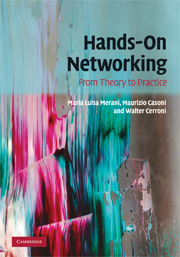4 - Wireless networks
Published online by Cambridge University Press: 05 June 2012
Summary
The intent of this chapter is to complement the previous discussion on wired LANs, providing a thorough picture of the technologies and standards available today to build wireless network infrastructures. These aim to cover a wide range of areas successfully, spanning from personal to local and metropolitan coverage solutions.
The impressive pace of technological advances of the last decade has acquainted us with technologies that replace cable over very short distances, as testified by palm computers, cellular headsets and plenty of technological “toys” equipped with Bluetooth ports. Wireless LANs have an unprecedented popularity too, rapidly pervading private houses and enterprises; in metropolitan areas, municipalities are also getting into the game, supporting projects of wireless connectivity for communities that would otherwise be confined to low-speed Internet access. This all started with some impressive – at the time – 1 and 2 Mbit/s raw transmission rates that the first Wireless LAN standard guaranteed: current products achieve 54 Mbit/s of raw throughput, rates of 250 Mbit/s are on the way, and the specifications for wireless MAN head to even higher data rates, extended coverage and mobility support.
The logical organization of the chapter reflects the colloquial description above: the first section is devoted to wireless LANs and to the corresponding set of specifications, belonging to the IEEE 802.11 family of standards; the second section deals with the issue of fixed – and mobile – radio broadband access that wireless MANs have to provide. For the sake of completeness, the next sections rapidly look at wireless personal area networks (WPANs) and wireless mesh networks. The chapter is closed by some practical – and crucial – considerations on traffic monitoring and security issues in wireless networks.
- Type
- Chapter
- Information
- Hands-On NetworkingFrom Theory to Practice, pp. 97 - 135Publisher: Cambridge University PressPrint publication year: 2009



